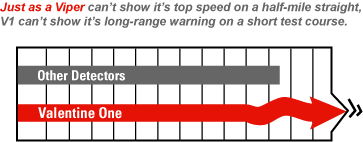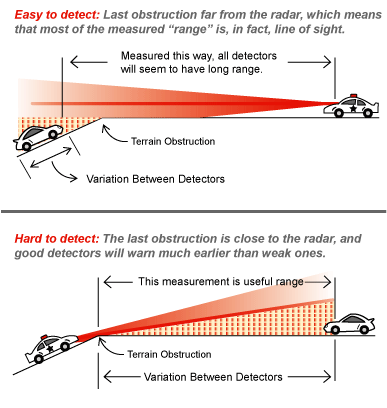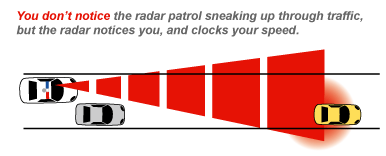Evaluating Radar Detector Tests
Finding the Best Radar Detector
1. Are the test samples honest?
For its February, 1979, test, Car and Driver requested samples from detector makers. I delivered an Escort (I was president of that company then), Fuzzbuster delivered a test unit, and ten other makers provided theirs by various means.
During the test, C/D got suspicious of the Fuzzbuster, so the tester went off to a local discounter and bought a supposedly identical model over the counter. The factory sample vastly outperformed the store-bought unit. So he drilled the rivets out of both Fuzzbuster cases to expose their circuitry. They were completely different inside. Fuzzbuster had, in effect, stuffed an Escort motor in a Fuzzbuster case, and sent the souped-up cheater off to the races.
Fuzzbuster got caught. C/D printed the story. There were pictures. Justice was done.
The point here is that tests are make-or-break showdowns for all detector makers. The temptation to submit a hot sample is simply too great for some to resist.
Who gets hosed if the maker pulls a switcheroo? Not the magazine. Only the consumer, when he pays up for the winner, only to discover he doesn’t get the protection promised by the test.
To keep the results honest, the tester must buy the units the same way customers do, at retail. And it must be a “blind” buy; that is, the maker can’t know which retailer will be contacted. This is an essential precaution. Because testers always want the newest model, the one that isn’t on all the shelves yet. So they ask the maker “Who has it.” “Well, we know that XYZ will have one by Monday.” It’s too easy to supply a “special” test unit when you know exactly where to send it.
Buying blind from us is simple. Any tester can have his mother-in-law call 800-331-3030.
2. Are the test conditions well controlled?
If measurements aren’t repeatable, they aren’t measurements. To get repeatability, conditions must be exactly the same run after run. Here are just four of many requirements:
This assures that each oncoming detector faces the same beam intensity. I would be surprised if anyone could hold a radar or laser gun within five degrees of aim run after run all day long. But on a one-mile range, a five degree shift means you hit one detector with the hot part of the beam, and shoot 460 feet over the head of the next one. Even if they’re equally sensitive, one detector will respond and the other may not.

B: The test range has to be empty of moving vehicles, except for those involved in the test.
Moving traffic reflects radar unpredictably; actual highways are never empty enough for repeatable results. Even construction equipment operating near the road can bounce the beam to the advantage of one detector.
C: No detector-maker’s reps allowed near the test.
It’s too easy for someone to conceal a transmitter that would signal his detector at the opportune time.
D: The test range can’t run out of room.
Even the best testers screw up sometimes. For its September, 1995, test of cheap detectors, Car and Driverthrew a V1 into the mix, supposedly to show how much protection you lose by buying low-cost units. Unfortunately, the test range was sized for the weak performers; V1 maxed out the range at 2.4 miles on both X and K bands. No one knows how much warning distance it really offered because the testers had no room to measure more. Worse yet, the author simply presented the results in the magazine, with no mention that V1 performance was limited by the length of the test road, not by its sensitivity.

Throw the red flag when you see bar graphs running the full length of the grid. In that 1995 test, the readers came away with the mistaken notion that cheap detectors perform almost as good as the best radar detectors on some tests.
3. Does the test mimic the consumer’s problems?
Radar behaves like the headlights of an oncoming car. Like a light beam, radar travels in straight lines, and it’s completely blocked by solid objects. When oncoming headlights are still behind a hill, you see only a faint glow, which brightens as they approach the crest.

Once headlights break over the hill and into the open, you can see them miles away, and the driver of that car can see yours. Same for radar. Your detector sees radar, the radar sees you, the game is over. Those long-range alerts in some detector tests—five miles, seven miles, or more—are irrelevant for this simple reason…detector users don’t get nailed at five miles, or seven. It’s so easy for a detector to see unobstructed radar coming that radar enforcers don’t even try beyond a half mile or so. Instead, they hide in ambush, waiting till you are up close.
Enforcers are ambush experts. They hide behind a hill or a bridge abutment, using that obstruction to block your detector’s view of the beam until you’re up close and within range. Then, as you pop into the full brightness of the beam, zap! you’ve been read.
To defend, a detector must find radar before the bright part of the beam is in full view. If it can’t find the glow behind the hill, it can’t warn you. To see the benefit of a high-performance detector like V1, a test must be set up like a real radar trap: How much warning do you get from just the glow beyond the hill?

B: Does the test try detectors against Instant On radar?
Some detectors, to avoid false alarms, ignore short, weak signals. Which means they ignore weak Instant On radar too. You don’t want to find that out after you buy.
C: Does the test try detectors against moving radar approaching from the rear?
A number of moving radars (Stalker Dual DSR, MPH Python Series II FS, Kustom Golden Eagle and some Kustom Talon models) have a same-lane, same-direction feature used every day to nab drivers from behind. What warnings will the detectors provide against those threats?

D: Does the test use a variety of radar guns, particularly on Ka band?
Ka band extends from 33.4 to 36.0 GHz, ten times the bandwidth of X and K bands put together. Different Ka guns operate on different frequencies within that wide band. How well does each detector perform against all Ka guns?
E: Does the test include photo radar?
Most photo radars operate on Ka band, but there are exceptions. Unlike ordinary radar traps, which use terrain to stay out of sight, photo radar usually operates out in the open. Instead of hiding, it minimizes detection range by using a low-power beam angled across the road. So warning range is short, too short if you have a weak detector. Because photo radar works out in the open, it should be tested that way too.
The bottom line:
- Do the testers convince you that the test detectors are typical of what you could buy?
- Do their procedures eliminate spurious interference from traffic and from biased personnel?
- Do the tests simulate real traps you’ll face?
If you can say yes to all these questions, the test should be a helpful guide to the state of the detector art.
Report #6: Laser Detectors Tests… sloppy methods bring worthless results. Here’s what you should know.
